
All categories
Featured selections
Trade Assurance
Buyer Central
Help Center
Get the app
Become a supplier

(2624 products available)



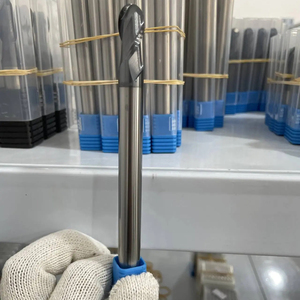









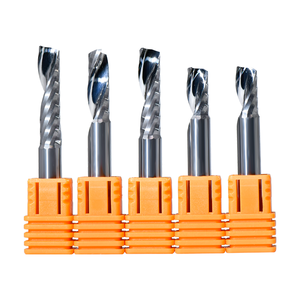









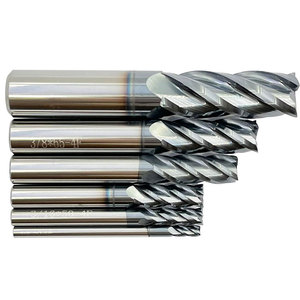

















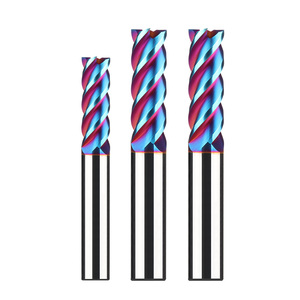


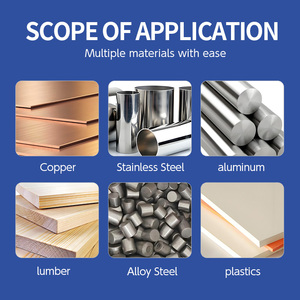
The solid carbide endmill 1 flute type is one of several common designs manufactured for cutting tasks in various industries, especially in machining and manufacturing. The main differences relate to the cutting edge number, the helix angle, and the length of the cutting edge. Each type is optimized, considering the nature of the material being processed, the depth of cut, and the required surface finish.
Solid carbide endmills 1-flute types are ideal for specific cutting tasks because of their single cutting edge. In particular, they are well suited for tasks involving soft and sticky materials, such as aluminum, copper, plastics, and some composites. This is because the single cutting edge is better at removing larger chips from the workpiece than multiple finer edges would. Large chips effectively reduce the cutting edge contact with the workpiece, thus eliminating the tendency of softer materials to deform or smear over the cutting surface. Large chips also reduce heat generation at the cutting zone, a factor that could damage or distort some materials.
2-flute carbide endmills
The 2-flute solid carbide endmill is a versatile and widely used tool. The additional helix cutting edge expands the range of materials that can be machined and offer better control of the chip formation and heat dissipation. 2-flute endmills are therefore well suited for such jobs as milling, slotting, and edge breaking in a wide variety of materials that include aluminum, copper, plastics, stainless steel, and titanium. Their generally modest geometry makes them suitable for a wide range of cutting depths and feeds, meaning they can deliver acceptable performance across a spectrum of machining needs.
3-flute carbide endmills
The 3-flute solid carbide endmill is a specialized tool. Its three cutting edges provide certain advantages when machining materials that tend to be hard, brittle, or prone to chipping, such as heat-treated steels, carbide composites, titanium alloys, and glass-fiber-reinforced plastics. The additional flute improves chip evacuations, which is important when cutting hard materials that generate small but potentially damaging chips. The 3-flute endmill also better manages heat dissipation, another factor that hard and heat-sensitive materials are sensitive to. The design, with its three flutes, allows for deeper cuts and feeds suitable for high-performance milling.
4-flute carbide endmills
The 4-flute solid carbide endmill is a common and broadly useful milling tool. Its four cutting edges provide certain benefits for machining a variety of materials. The additional flutes allow a more refined cut and better chip removal, particularly useful when processing ductile materials such as mild steel, aluminum, and copper, which can be easily deformed or smeoshed. The increased rigidity of the endmill also allows more precise work and tolerances. Typical applications include general-purpose milling, drilling, and complex shape cutting in metals and plastics where a smooth finish and dimensional accuracy are required.
The specifications of the solid carbide endmill 1 flute type are primarily concerned with such standard aspects as material, geometry, and coating. These specifications determine the endmill's performance, longevity, and suitability for different machining jobs.
The main and defining characteristic of a solid carbide endmill is, of course, that it is made of solid carbide. Solid carbide is chosen for its extraordinary hardness and ability to resist deformation under extreme heat and pressure. These properties make solid carbide endmills ideal for maintaining sharp cutting edges over long periods of demanding work. The specific grade of carbide used in making the endmill can enhance performance and wear resistance through the inclusion of other hard materials such as cobalt, tungsten, and vanadium. These materials form a tough bond that secures the carbide grains in place.
The geometrical features of the solid carbide endmill 1 flute type have specific roles in making the endmill effective within given operational limitations. Important geometrical features of the endmill type, other than the number of flutes, include the helix angle, which is the angle formed by the cutting edges with the endmill axis, and the length and diameter of the cutting edges. A typical helix angle for 1-flute endmills is small, generally between 20° and 30°. A lower helix angle ensures that the cutting action is more shearing than lifting. This is an advantage when machining materials that tend to deform or smear because it reduces the material's disruption at the cut edge.
The 1-flute design incorporates a single cutting edge, which is substantial relative to the overall diameter of the tool. This flute is optimized for removing a large volume of chips with each rotation. The one-flute geometry is particularly effective on soft materials because it maximizes the contact area between the cutting edge and the workpiece. The wider cutting edge also dissipates heat, protecting sensitive materials from potential damage during the machining process. The endmills are available in a range of diameter sizes, typically between 0.5 mm and 12 mm, depending on the requirements of the job. Size is an important consideration, as smaller diameter endmills are more effective for fine details or shallow cuts, while larger diameters have greater rigidity, which is important for heavy-duty cutting tasks or machining hard materials.
Coatings extend the life of the endmills and expand their machining applications. Endmills are typically uncoated or have such coatings as titanium nitride (TiN), titanium carbonitride (TiCN), and diamond-like carbon (DLC) to reduce wear, increase hardness, and decrease friction, respectively. The selection of coating material is influenced by the characteristics of the material being machined and the nature of the cutting operation.
The one-flute solid carbide endmill is highly prized for its efficiency in certain milling operations across a range of industries. Its unique design makes it especially suitable for machining specific materials and produces desirable outcomes in those jobs.
Their capability to remove large chips with each rotation makes them outstanding performers when machining soft materials. Materials like aluminum, copper, and various plastics tend to deform or smear under the pressure of cutting tools with finer edges. The one-flute endmill's broader cutting edge reduces this smearing, allowing softer materials to be cut cleanly, with better surface definition and minimal deformation. This is particularly noticeable in aerospace, automotive, and machine components where lightweight, high-precision parts are manufactured. In these industries, aluminum and its alloys feature prominently among the materials used for machining.
One of the primary roles of a one-flute endmill is in the machining of plastics. Plastics are widely used in many industries, including automotive for interior components, electronics for lightweight casings and devices, and medical for custom implants and medical devices. However, plastics can also distort under cutting pressure, which makes it essential to use a cutting tool that minimizes heat generation and contact pressure. The one-flute endmill meets these essential requirements.
Copper and its alloys are other soft metals commonly machined with a 1-flute endmill. Copper, with notable applications in electrical wiring and automotive components, requires a machining process that maintains its dimensionality. The one-flute endmill achieves this by producing cleaner cuts with less risk of edge deformation.
Moreover, this type of endmill is highly effective in milling operations that demand precision but not in depth or width, such as engraving, lettering, and making fine details in a workpiece. In industries like electronics, 1-flute endmills are used to carve intricate patterns on circuit boards. This is done to achieve high-accuracy prints essential for the performance of electronic devices. The one-flute design minimizes the risk of the fragile material breaking or chipping during the cut, which is crucial in this operation.
The solid carbide endmill 1 flute has a number of important advantages over other types of milling tools in terms of material, design, and application. These advantages make it a preferred endmill in many machining operations demanding high precision and desirable surface finishes.
Compared to other materials used to make cutting tools, solid carbide is a super dense material with a high degree of rigidity. Because of this density, endmills made of solid carbide have superior resistance to wear and breakage. In particular, they maintain sharp cutting edges for much longer under heavy-duty machining operations. This lack of edge deformation means that the endmills are able to cut with a very high degree of accuracy without the operator needing to stop to replace or resharpen the tool. This increased tool life is not only very beneficial in terms of reducing operating costs, but also results in increased productivity due to fewer interruptions in the machining process.
One of the main advantages of a 1-flute design is that it has extended applications. As already noted, this type of endmill is particularly suited to machining soft materials such as aluminum, copper, and certain plastics. The one-flute design cut more material with each pass than the multi-flute designs and thus produced large chips that reduced the contact between the workpiece and cutting edge. This made it highly effective at reducing the tendency of soft metals to smear or fold over, which could otherwise clog the cut and ruin the workpiece.
The 1-flute design is also good for operations in which precision is more critical than breadth or depth, such as engraving fine details on materials without risking damage to those delicate pieces. This is crucial in industries such as electronics, where small and intricate components are the norm. One-flute endmills also have the added benefits of lower heat generation and improved chip evacuation, which are critical when machining sensitive materials.
Furthermore, 1-flute endmills are frequently coated with such materials as titanium nitride (TiN) and diamond-like carbon (DLC). These are referred to as hard coatings that protect the endmill from wear during cutting operations. More significantly, the coating reduces friction at the cutting edge, further protecting the workpiece and improving the endmill's effectiveness at heat dissipation. By extending tool life and improving performance, coatings further enhance productivity and the reduction of costs.
A1: While 1-flute endmills excel at machining soft materials due to their chip-removal capacity, they are generally unsuitable for hard materials. The single flute is not designed to withstand the high cutting forces required to effectively machine harder substances. When used on hard materials, the endmill is prone to edge chipping, fracture, or rapid wear due to the excessive heat generated and poor chip evacuation. For these materials, endmills with more flutes are better suited, as they are able to share the cutting load and dissipate heat more effectively.
A2: The choice of endmill depends on the specific requirements of the machining operation to be performed. Key factors are the material being machined and the desired surface finish and dimensional tolerance. Thus, the number of flutes will be determined by these requirements. For example, 1-flute endmills are ideal for machining soft materials where large chip removal is more important than delicate cutting. On the other hand, harder materials prefer endmills with more flutes because they can handle greater cutting forces and facilitate better chip evacuation. Other considerations include the diameter of the endmill, which should be compatible with the feat and depth of cut; and the type of tool geometry, such as helix angle and cutting edge profiles, which affect the cutting action.
A3: Coatings on solid carbide endmills are advantageous because they improve endmill performance and prolong tool life. Among the most common coatings are titanium nitride (TiN) and titanium carbonitride (TiCN). These hard coatings reduce friction at the cutting edge during the operation and hence improve the tool's resistance to wear. This wear resistance is particularly critical in long and demanding machining operations. Additionally, coatings protect the endmill from chemical reactions with certain workpiece materials that would damage the cutting edge. This protection significantly increases the number of machined parts that can be produced before tool change is needed. Besides, coatings decrease heat generation at the cutting edge, which protects both the endmill and the workpiece from potential damage during the machining process.